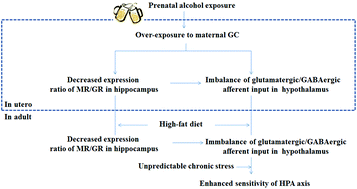Prenatal ethanol exposure induces an intrauterine programming of enhanced sensitivity of the hypothalamic–pituitary–adrenal axis in female offspring rats fed with post-weaning high-fat diet
Abstract
Our previous study demonstrated that prenatal ethanol exposure (PEE) enhances the sensitivity of the hypothalamic–pituitary–adrenal (HPA) axis in adult offspring rats. This study aims to investigate the underlying mechanism. PEE treated female offspring rats were fed with high-fat diet and subjected to the unpredictable chronic stresses (UCS) in adulthood. For adult offspring, the PEE group exhibited increased expression of hypothalamic corticotrophin-releasing hormone (CRH) and arginine vasopressin (AVP) as well as elevated gain rates of serum adrenocorticotropic hormone (ACTH) and corticosterone after UCS. Meanwhile, PEE significantly decreased the expression of glutamic acid decarboxylase 65 (GAD65) and Reelin (Reln), and the expression ratio of hypothalamic vesicular glutamate transporter 2 (VGluT2)/GAD65 was enhanced in the adult PEE offspring. These changes were also accompanied by the enhanced expression of glucocorticoid receptor (GR), N-methyl-D-aspartate-subtype glutamate receptor 2B and the decreased expression ratio of mineralocorticoid receptor (MR)/GR in the hippocampus. Furthermore, the abnormal hippocampus neurons were observed especially in the cornu ammonis 3 (CA3) and dentate gyrus subfields. For fetuses, PEE significantly decreased the expression of mammalian achaete-scute homolog-1 (Mash1) as well as GAD65 and Reln. Both VGluT2/GAD65 expression ratio and GR expression were increased while the MR/GR expression ratio was decreased in the PEE group. PEE also caused ultrastructural injury in CA3. Our findings suggest that PEE causes the persistent remodeling alterations of impaired morphology and decreased MR/GR expression ratio in the hippocampus, as well as the imbalanced glutamatergic/GABAergic afferent inputs in the hypothalamus. All of these would contribute to the enhanced sensitivity of the HPA axis in adult offspring.


 Please wait while we load your content...
Please wait while we load your content...